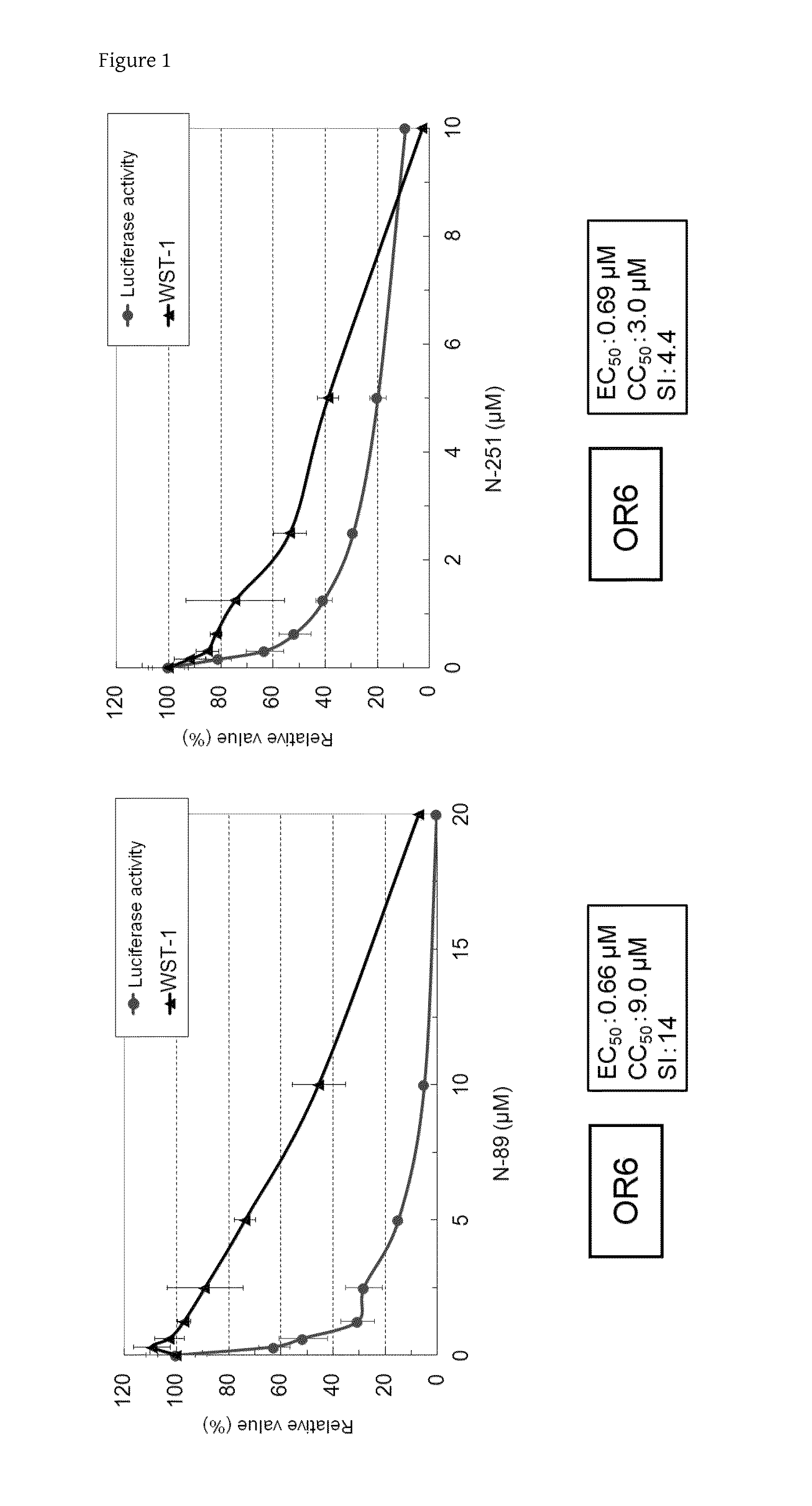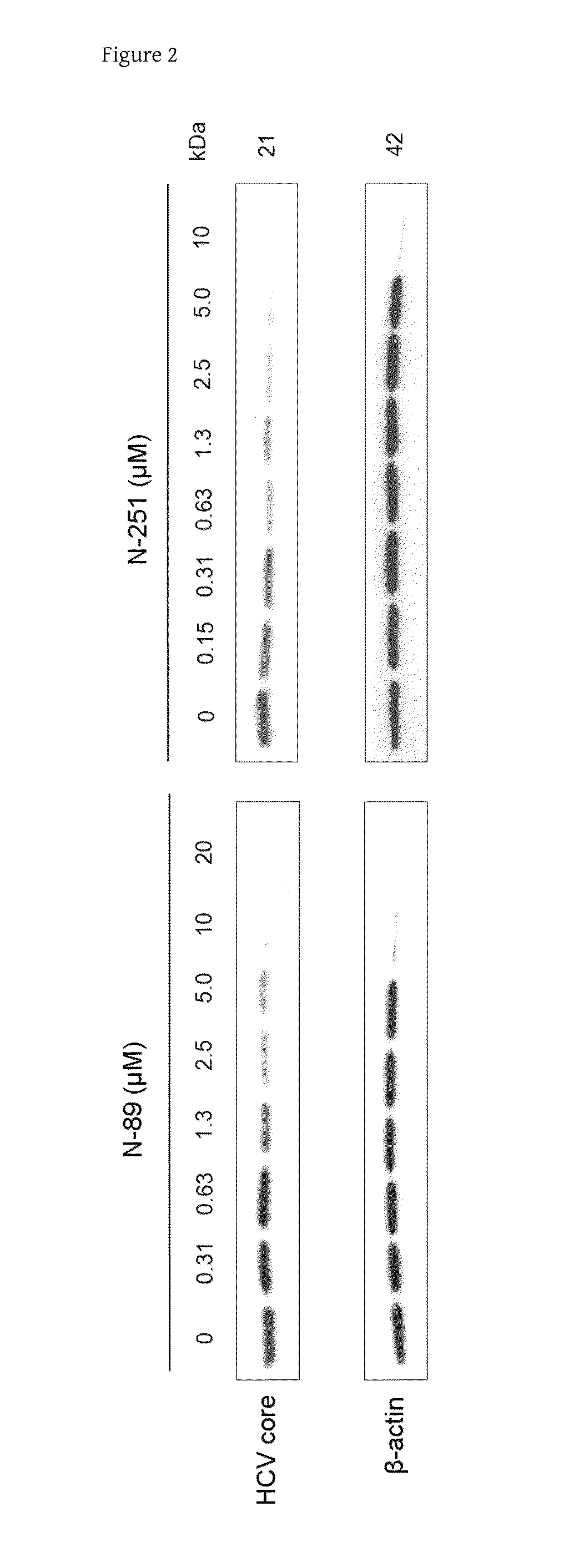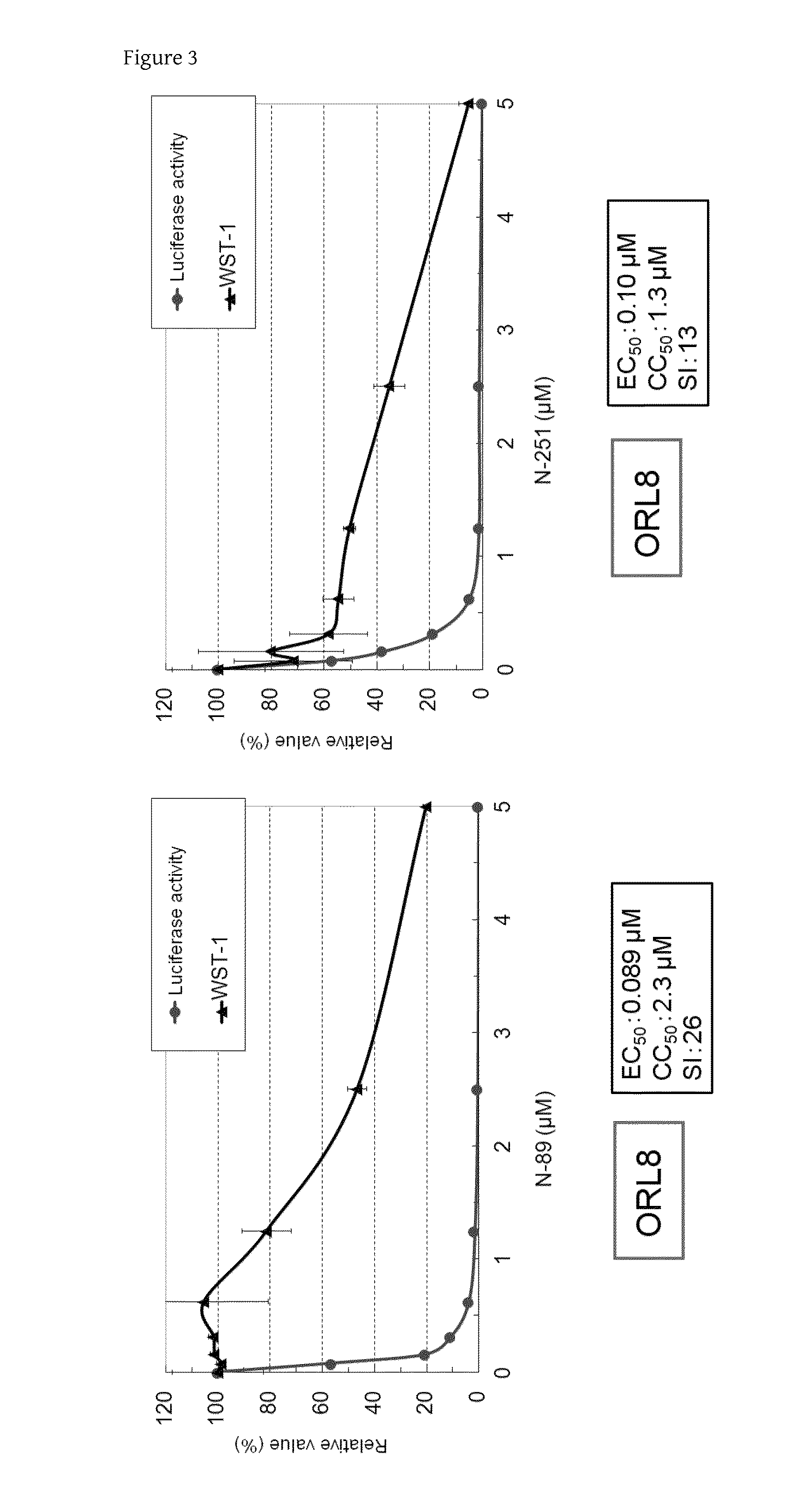Anti-HCV agent
a technology of hepatitis c virus and anti-hcv, which is applied in the field of new anti-hcv agents, can solve the problems of unresolved, system can be utilized, and large number of older people that cannot be treated, and achieve the effects of improving the cure ratio, potent anti-hcv action, and increasing the therapeutic effect of hepatitis
- Summary
- Abstract
- Description
- Claims
- Application Information
AI Technical Summary
Benefits of technology
Problems solved by technology
Method used
Image
Examples
reference example 1
Cells and Evaluation Methods for Anti-HCV Activity and Cytotoxic Effect Used in the Present Invention
[0068]Assay systems using OR6 cells (HCV-O strain), 1B-4R cells (HCV-1B-4 strain), and AH1R cells (HCV-AH1R strain) as HuH-7 cell-derived full-length HCV-RNA-replicating cells, and ORL8 cells (HCV-O strain), ORL11 cells (HCV-O strain), 1B-4RL cells (HCV-1B-4 strain), and KAH5RL cells (HCV-KAH5 strain) as Li23 cell-derived full-length HCV-RNA-replicating cells were used for the quantitative analysis of anti-HCV activity and evaluation of a cytotoxic effect in the present invention. The three cell lines, i.e., the 1B-4R cells, the 1B-4RL cells, and the KAH5RL cells have been disclosed in WO 2010 / 026965 A1. The AH1R cells may be produced with reference to Mori K et al., BBRC, 371:104-109, 2008 and WO 2010 / 026965 A1. In addition, all the HCV strains belong to genotype 1b.
[0069]For the anti-HCV activity, renilla luciferase activity was quantitatively measured and a 50% effective concentra...
example 1
Anti-HCV Activities of N-89 and N-251 in OR6 Cells
[0073]The anti-HCV activities of N-89 and N-251 were examined using OR6 cells and the EC50 values were calculated.
[0074]OR6 cells, which had been cultured in general medium for subculture, were plated onto a 24-well plate (2×104 cells in 1 mL of medium for Li23 cell line per well) and cultured. After 24 hours, N-89 was added so as to achieve concentrations of 20 μM, a 2-fold dilution series from 20 μM (10, 5, 2.5, 1.3, 0.63, and 0.31 μM), and 0, or N-251 was added so as to achieve concentrations of 10 μM, a 2-fold dilution series from 10 μM (5, 2.5, 1.3, 0.63, 0.31, and 0.16 μM), and 0. The renilla luciferase activities were measured 72 hours after the culture. N-89 and N-251 were diluted with DMSO.
[0075]As a result of the measurement, the EC50 values of N-89 and N-251 were calculated to be 0.66 μM and 0.69 μM, respectively (FIG. 1).
[0076]The cytotoxic effects of N-89 and N-251 were examined using OR6 cells and the CC50 values were c...
example 2
Analysis of Influences of N-89 and N-251 on HCV Core Protein Expression in OR6 Cells
[0080]The Western blot analysis of an HCV core protein was performed in order to confirm the anti-HCV activities of N-89 and N-251 in OR6 cells.
[0081]OR6 cells, which had been cultured in general medium for subculture, were plated onto a 6-well plate (5×104 cells in 3 mL of medium for Li23 cell line per well) and cultured. After 24 hours, N-89 was added so as to achieve concentrations of 20 μM, a2-fold dilution series from 20 μM (10, 5, 2.5, 1.3, 0.63, and 0.31 μM), and 0, and N-251 was added so as to achieve concentrations of 10 μM, a 2-fold dilution series from 10 μM (5, 2.5, 1.3, 0.63, 0.31, and 0.16 μM), and 0. N-89 and N-251 were diluted with DMSO. After 72 hours, sampling was performed with 100 μL of 2×SDS buffer. 10 μL of a sample were applied to SDS-PAGE electrophoresis and subjected to Western blot analysis using an anti-HCV core antibody and an anti-β-actin antibody according to a conventio...
PUM
| Property | Measurement | Unit |
|---|---|---|
| time | aaaaa | aaaaa |
| concentrations | aaaaa | aaaaa |
| concentration | aaaaa | aaaaa |
Abstract
Description
Claims
Application Information
 Login to View More
Login to View More - R&D
- Intellectual Property
- Life Sciences
- Materials
- Tech Scout
- Unparalleled Data Quality
- Higher Quality Content
- 60% Fewer Hallucinations
Browse by: Latest US Patents, China's latest patents, Technical Efficacy Thesaurus, Application Domain, Technology Topic, Popular Technical Reports.
© 2025 PatSnap. All rights reserved.Legal|Privacy policy|Modern Slavery Act Transparency Statement|Sitemap|About US| Contact US: help@patsnap.com



